|
|
|
Sort Order |
|
|
|
Items / Page
|
|
|
|
|
|
|
| Srl | Item |
| 1 |
ID:
148472
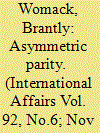

|
|
|
|
|
| Summary/Abstract |
The period 2008 to 2015 is likely to prove a traumatic transition from the post-Cold War era of American unipolar hegemony to a new status quo of asymmetric parity between the US and China. With approximately equal masses of production and one third of the world's total, the relationship of the United States and China will remain the focus of global politics for the foreseeable future. While parity in economic mass makes each the greatest concern of the other, their asymmetry in wealth, developmental levels, and geopolitical concerns makes unnecessary a power transition scenario. Hitherto the analysis of parity has assumed symmetry, and therefore the point of power transition and challenge is highlighted and strategy has focused on relative gain vis-à-vis the rival. With asymmetric parity the transitional moment becomes ambiguous, and it is a reasonable strategy for each side to pursue absolute gain. Sustainable asymmetric rivalry is competitive, but it can also be win-win. Moreover, neither the US nor China—nor the two together—can exercise the kind of hegemonic control that was the premise of earlier bipolar and unipolar eras. The diffuse interdependence created by globalization gives every state broader alternatives and raises the cost of hostility. The US and China do not face each other as hegemon and challenger, but rather as the largest, but quite different, players in a multinodal world that neither controls.
|
|
|
|
|
|
|
|
|
|
|
|
|
|
|
|
| 2 |
ID:
111215
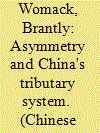

|
|
|
|
|
| Publication |
2012.
|
| Summary/Abstract |
In his article, 'Equilibrium Analysis of the Tributary System', Zhou Fangyin presents an important and stimulating application of the game theory of patterns of interaction to China's traditional diplomacy with its neighbors.1 His analysis contradicts the realist expectation that the larger power would simply dominate smaller powers in the context of international anarchy. However, his explanation of the tributary system does not rely on a cultural explanation based on Confucian morality, but rather on processes of conflictual interaction that lead to mutual accommodation between China and its neighbors.
Zhou rightly emphasizes the two-way character of the tributary system and the centrality of its basic idea for Chinese diplomacy. In contrast to John Fairbank, he argues that it is more than a diplomatic cover for a trade relationship. In contrast to the general assumption that tribute is a form of booty that a larger power requires from a smaller power, he emphasizes China's primary interest in stabilizing its relationships with neighbors through concessions. Indeed, it appears from Zhou's narration that China is at the disadvantaged side of tributary relationships: frustrated in conflicts and conceding to neighbors in order to pacify its borders. By providing a clear and plausible model for interaction and interesting, complex cases of processes through which to arrive at equilibrium, Zhou has, indeed, made a contribution to both theory and history.
|
|
|
|
|
|
|
|
|
|
|
|
|
|
|
|
| 3 |
ID:
052009


|
|
|
|
|
| Publication |
May 2004.
|
| Summary/Abstract |
Since 1986 the concept of multipolarity has played a key role in China's analysis of the world order, evolving from a critique of bipolarity in the late Cold War period into a critique of American unipolarity. Although multipolarity is empirically correct in its questioning of the superpower's capacity for domination and it is ethically attractive in its insistence on international cooperation, it does not address the real problems created by the disparity of power in international affairs. Asymmetry theory is a new paradigm that addresses the effects of national disparities on international relations. It argues that asymmetry inevitably creates differences in risk perception, attention and interactive behavior between states, and that it can lead to a vicious circle of systemic misperception. Despite such tensions, however, the international order is quite stable, and even asymmetric relations can rarely be forced by the stronger side. Asymmetry confirms multipolarity's critique of unipolarity's exaggerated claim to absolute power, and suggests a theory of international leadership based on negotiated relationships that avoid the systemic misperceptions that asymmetry encourages.
|
|
|
|
|
|
|
|
|
|
|
|
|
|
|
|
| 4 |
ID:
123985
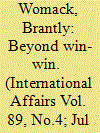

|
|
|
|
|
| Publication |
2013.
|
| Summary/Abstract |
China is the least disadvantaged major economy in the current era of global economic uncertainty. Thus it is becoming the focus of attention of its neighbours and is achieving a prominence in the world political economy unparalleled in its modern history.
To a great extent, China's success is the result of 'good neighbour diplomacy' such as 'win-win' and the policies of reform and openness of the past thirty years. However, despite continuity in policy, China's 'peaceful leap forward' since 2008 has changed the context of its external relationships. The increasing asymmetries between China and its neighbours, as well as decreasing asymmetry with the United States, require an adjustment of win-win values beyond mutual benefit to credible reassurance.
As China's neighbours become more dependent, they also become more anxious concerning their interests. Meanwhile, China's relative gain on the US requires a different kind of confidence-building diplomacy.
|
|
|
|
|
|
|
|
|
|
|
|
|
|
|
|
| 5 |
ID:
052525


|
|
|
|
|
| Publication |
Winter 2003-04.
|
|
|
|
|
|
|
|
|
|
|
|
|
|
|
|
| 6 |
ID:
139156
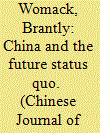

|
|
|
|
|
| Summary/Abstract |
Although China’s underlying capabilities have developed at a fairly steady pace over the past 20 years and its ambitions have remained relatively stable, the shock of uncertainty and relative change since 2008 has driven an ongoing interaction between heightened international anxiety over China’s rise and greater assertiveness on China’s part. In academic circles, the question is raised whether China is a status quo power willing to be a stakeholder in the existing international system, or whether it has ambitions to be a revisionist power challenging the existing order. The resulting tension is especially acute in East Asia and in relations between China and the United States. Given the novel dynamics of the current era of global economic uncertainty, international normalcy should not be judged by the status quo of the post-Cold War era but rather by a ‘status ad quem’, a future situation of sustainable relationships in a post-hegemonic era. The prospective diplomacy of all states should be judged by the likelihood of their accommodation to a new era.
|
|
|
|
|
|
|
|
|
|
|
|
|
|
|
|
| 7 |
ID:
131065
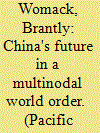

|
|
|
|
|
| Publication |
2014.
|
| Summary/Abstract |
Over the next twenty years China is likely to become the world's largest national economy, though not the richest one-fifth of the world's population. Chinese demographic power will be qualitatively different from American technological power despite bottom-line similarities in GNP, and China will face challenges of political and economic sustainability. Assuming that globalization, constrained state sovereignty, and demographic revolution continue as basic world trends, the world order is likely to be one in which concerns about conflicts of interests drive interactions, but no state or group of states is capable of benefitting from unilaterally enforcing its will against the rest. Thus, there is no set of "poles" whose competition or cooperation determines the world order, despite the differences of exposure created by disparities in capacity. Although the United States and China will be the primary state actors and their relationship will contain elements of rivalry as well as cooperation, the prerequisites of Cold War bipolarity no longer exist. Rather, the order would be best described as "multinodal," a matrix of interacting, unequal units that pursue their own interests within a stable array of national units and an increasing routinization of international regimes and interpenetrating transnational connections
|
|
|
|
|
|
|
|
|
|
|
|
|
|
|
|
| 8 |
ID:
100903
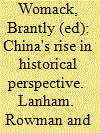

|
|
|
|
|
| Publication |
Lanham, Rowman and Littlefield Publishers, 2010.
|
| Description |
ix, 286p.hbk
|
| Standard Number |
9780742567214
|
|
|
|
|
|
|
|
|
|
|
|
Copies: C:1/I:0,R:0,Q:0
Circulation
| Accession# | Call# | Current Location | Status | Policy | Location |
| 055556 | 951/WOM 055556 | Main | On Shelf | General | |
|
|
|
|
| 9 |
ID:
131642
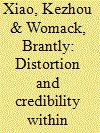

|
|
|
|
|
| Publication |
2014.
|
| Summary/Abstract |
Behind the problems of credibility of public official information in China lie two patterns of internal information distortion, one restricting the downward flow of sensitive general information and the other filtering the upward flow of local information. Information gathered at the center is increasingly restricted as it is transmitted down the bureaucracy. Meanwhile, the 'facts on the ground' are sifted by local official interests at each level of upward transmittal. Awareness of these distortions has been increased by the Internet revolution, but the structures that encourage them remain in place. An empirical survey of different levels of local cadres in Guangdong Province indicates the different perspectives produced by different positions in the internal information system. Municipal level officials, who have more general information but less diverse local information, tend to be more positive about the quality and objectivity of statistics, while their staff members, further from central sources but closer to messy local realities, are more skeptical.
|
|
|
|
|
|
|
|
|
|
|
|
|
|
|
|
| 10 |
ID:
156805


|
|
|
|
|
| Summary/Abstract |
The profound political uncertainties in international politics created by developments in the United States, Europe, the Middle East, and North Korea (DPRK) are similar in some respects to the economic uncertainties created by the global financial crisis of 2008. In both crises there is a sudden and general awareness of vulnerability, and it is unclear how long the current uncertainty will last. With the election of Donald Trump, the United States is again at the centre of a global crisis. China is again the least vulnerable of the major states. Everyone including China is disadvantaged by the current political crisis. However, in relative terms China stands to gain, as it did in 2008. The relative change in international relationships will be most obvious in Asia. The focus here is on the cycle of uncertainty that characterizes both crises. However, the effects of the current political crisis are likely to contrast with the effects of the earlier economic crisis. From 2008 to 2014, other countries were worried about their own economies and about the world economy in general, and also about what China’s arrival as a regional and global economic power might mean for them. Meanwhile, American leadership under Obama seemed less assertive, while China appeared to be more assertive. By contrast, in 2015, China’s economy had already entered a ‘new normal’ of slower economic growth, while its consolidated political leadership supports multilateral globalization. American political leadership is unpredictable in both general strategic terms and in terms of crisis management. Just as the world needed the economic lift provided by China in 2008, it now needs the political reassurance of stability that China appears to provide. However, the United States may find it difficult to adjust to the shift in political influence.
|
|
|
|
|
|
|
|
|
|
|
|
|
|
|
|
| 11 |
ID:
167483
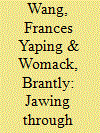

|
|
|
|
|
| Summary/Abstract |
Winston Churchill once said, ‘it is better to jaw-jaw than to war-war.’ However, negotiations are particularly difficult when they are enmeshed in public opinion precommitments. The sharpest crisis between China and Vietnam in the last 30 years concerned the placement of a Chinese oil rig into contested waters in 2014. This study analyses the Chinese and Vietnamese propaganda efforts surrounding the crisis as examples of the instrumental use of propaganda in managing domestic public opinion on diplomatic crises. The article argues that despite very different approaches to public diplomacy during the crisis, both states were primarily concerned with avoiding escalation and ending the confrontation. The authors show how propaganda function as a pacifying device in dealing with rising domestic nationalism when executing a moderate foreign policy.
|
|
|
|
|
|
|
|
|
|
|
|
|
|
|
|
| 12 |
ID:
134179


|
|
|
|
|
| Publication |
2014.
|
| Summary/Abstract |
In a globalized world characterized by direct interactions among states of different capacities, regional relationships must be considered in terms of their broader global context. States cannot change their location; therefore, engagement with neighbors has a particular importance in terms of present relations, historical memories, and future prospects. States are more anxious in a multinodal world because of increased regional and global exposure. However, it would be imprudent for them to act aggressively or to self-isolate because such behavior limits the potential for future beneficial exchange. In a multinodal world, partnerships are more rational than alliances. In East Asia, relationships will be asymmetric as in the past, but they should also be based on sovereign equality and global inclusiveness.
|
|
|
|
|
|
|
|
|
|
|
|
|
|
|
|
| 13 |
ID:
080488


|
|
|
|
|
| Publication |
2007.
|
| Summary/Abstract |
A situation of asymmetric stalemate exists when neither side can force a unilateral resolution of a conflict even though one side is significantly stronger than the other. Although a standoff can persist indefinitely, the only path to resolution of conflict is negotiation. Even though the conflict between China and the Dalai Lama regarding Tibetan autonomy is not one between sovereign states, it fits the pattern of asymmetric stalemate. Current discussions between China and the Dalai Lama illustrate the importance of recognition of autonomy on the part of the stronger side and of deference on the part of the weaker side in resolving asymmetric stalemate
|
|
|
|
|
|
|
|
|
|
|
|
|
|
|
|
| 14 |
ID:
108562


|
|
|
| 15 |
ID:
186723


|
|
|
|
|
| Summary/Abstract |
Throughout the CPC’s first century, its perception of global dynamics and its understanding of China’s own situation and interests have been bound together in fundamental interaction. Confucian dialectics is used to analyze the changing relationship of domestic and international aspects of CPC ideology. There was never a moment when both sides of the dialectic were not present, and never a decision taken that did not affect the balance and transformation of domestic and international factors. The course of the interaction has influenced a uniquely Chinese path of political development. Seven phases of the path are described, as well as the possibility of an eighth phase.
|
|
|
|
|
|
|
|
|
|
|
|
|
|
|
|
|
|
|
|
|